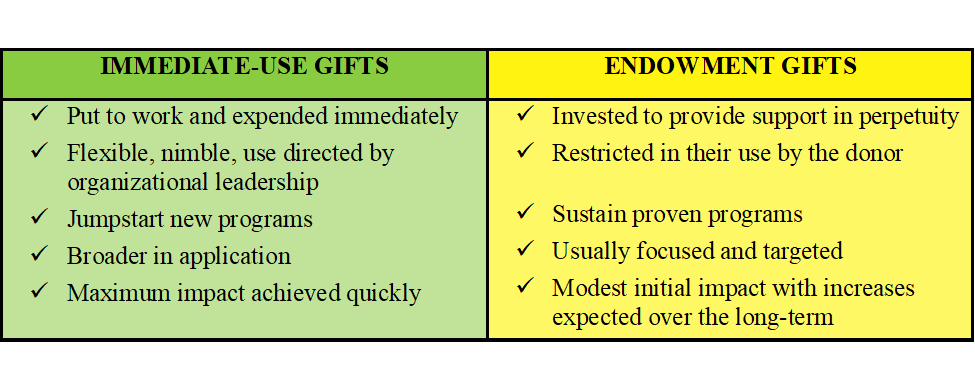I noticed that a consistent leadership annual fund donor had stopped giving through the annual fund and instead had pledged to fund an endowment. He had the financial resources to continue his annual fund support as well, but he hadn’t, and I wondered why. Imagine my surprise when I found the answer in a note he received from his relationship manager. My colleague wrote that when individuals reach a certain giving threshold, they no longer direct their gifts through the annual fund, but support endowment priorities instead.
While the message is rarely delivered so directly, the designation shift happens often. There are many reasons why fundraisers ask high-end annual fund donors to redirect their contributions to the endowment. These include the lack of a case for high-end annual giving, institutional pressure to grow the endowment, everyone’s comfort with nice, round numbers, and the fundraiser’s desire to ensure that donors receive meaningful stewardship.
No Compelling Case
The case for annual giving is often generic, essentially “help us execute our mission.” Donors, especially those considering larger philanthropic investments, want to understand the impact they will have. Fundraisers should have a compelling case for support for high-end immediate-use gifts, just as they have for targeted projects, capital needs, and endowment opportunities. The case should highlight the challenge the donor will help to overcome, tell the story of an individual who will benefit from the solution, and quantify the amount of funding needed to achieve success as tangibly as possible. If the donors understand how their funds will make a meaningful difference for others, they will be able to imagine themselves as the heroes of their own philanthropic story.
Push for Endowment Growth
Many nonprofits seek the stability that comes from an endowment with predictable annual expendable income (we hope!) to serve society in the long-term. This is great, but redirecting immediate-use gifts creates problems as well.
Per standard endowment payout practices, $10,000 given to the endowment will provide $400-500 to spend in the current year, while $10,000 for immediate-use will be fully spent. A donor who switches to endowment from current-use will have roughly one-twentieth of their previous impact, and the organization will need to find $9,500 more to cover the difference. Asking the donor to give to endowment and maintain some or all their immediate-use support will help operations continue as the endowment builds. The donor will fund the mission both today and tomorrow!
Consider a donor who has been giving $10K/year through the annual fund and is now being asked to establish an endowment with a $50K minimum gift. This is a terrific opportunity to raise the donor’s sights by inviting them to support the people who benefit from the institution’s amazing work immediately and over the long term by growing their giving.
If the donor isn’t ready or able to double their yearly contribution but wants to begin to support the endowment, don’t immediately lower the annual fund portion of the ask. Encourage them to sustain their immediate-use giving and add a more modest endowment commitment. You can accomplish this in two ways:
-
- Invite the donor to allocate their endowment gift to an existing fund that supports their area of interest but requires no minimum gift from them.
- Offer the donor a slight “discount” on the named endowment minimum in recognition of their decision to sustain their immediate-use support.
Comfort of Round Numbers
A colleague once commented, “I’m asking her to consider a gift of $1M; I can’t ask for $1.1M.” Studies confirm that humans strongly prefer “round numbers,” and our solicitors (for now, at least) and our prospective donors are all human. Endowment gift minimums, which are payable over up to five years and qualify donors who meet them for the stewardship mentioned below, are typically set with this in mind. While levels vary across organizations, they often fall into this list: $10K, $25K, $50K, $100K, $250K, $500K, $1M, $2.5M, $5M. Institutions shouldn’t miss out on much-needed immediate-use resources because the ask “sounds strange.” In these situations, present the two figures in the same conversation, but separately, inviting the prospective donor to give $100K over five years for immediate-use and $1M over five years to endow a professorship or program. The donor is much more likely to find it strange if you ask them for $1M, get a “yes,” and then follow up with “Thanks so much! Will you also commit to giving $20K/year through the annual fund for the next five years?”
Desire for Meaningful Stewardship
When fundraisers solicit donors for larger contributions, they want to know that the organization will provide the donor with excellent stewardship. So it’s not unusual to see donors solicited for endowment, as endowed fund donors typically receive annual reports on the use of the funds and their impact on the nonprofit’s mission. Sadly, donors providing immediate-use gifts at the same levels often don’t receive these kinds of impact reports. Given the value of these gifts (and their donors) to the execution of important societal missions, nonprofits must address the stewardship shortcomings for immediate-use or annual fund donors. Improving the donor experience is a win in every way.
Better Together
Both endowment and immediate-use gifts are needed by organizations, and their impact on their missions is very complementary. The table below sums up the key factors of each: This is why I always refer to endowment and immediate-use gifts as “the perfect pair.” Let’s make it our mission as fundraisers to invite major and principal gift donors to keep this terrific twosome together as they grow their giving. They’ll strengthen the future through the endowment and provide resources required to execute our vital missions today.
This is why I always refer to endowment and immediate-use gifts as “the perfect pair.” Let’s make it our mission as fundraisers to invite major and principal gift donors to keep this terrific twosome together as they grow their giving. They’ll strengthen the future through the endowment and provide resources required to execute our vital missions today.
Tammie L. Ruda

